Guadalajara is the capital city of Jalisco, the Mexican state famous for the town of Tequila and mariachi music.
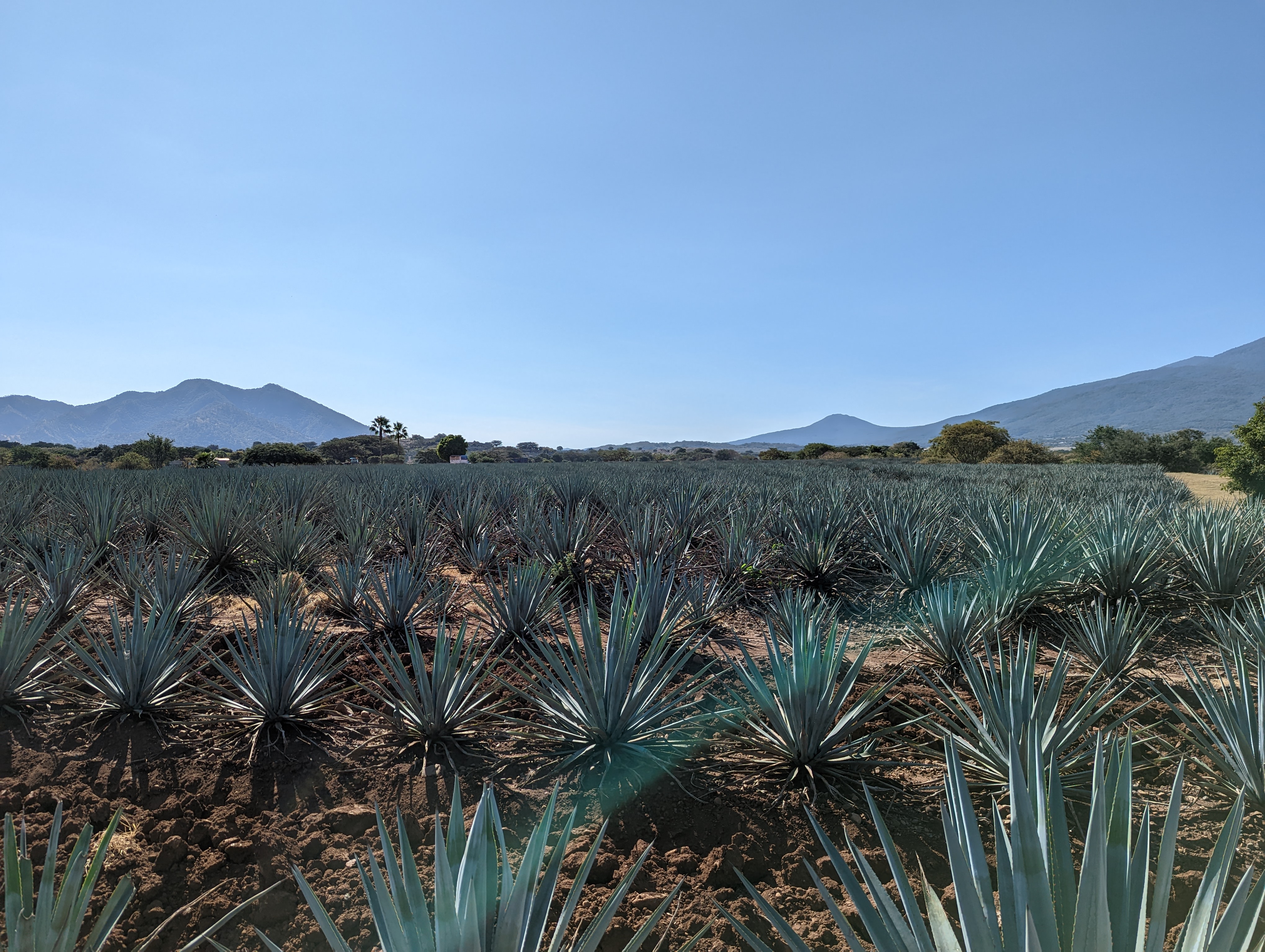
Agave fields outside the town of Tequila
We experienced both during our Jose Cuervo tour to Tequila. We booked a full day tour and as we discovered when we arrived at the meeting point, so did hundreds of others. We weren’t necessarily expecting a small group tour but the experience we got was quite something, and certainly a long way from the type of travel we tend to do these days.
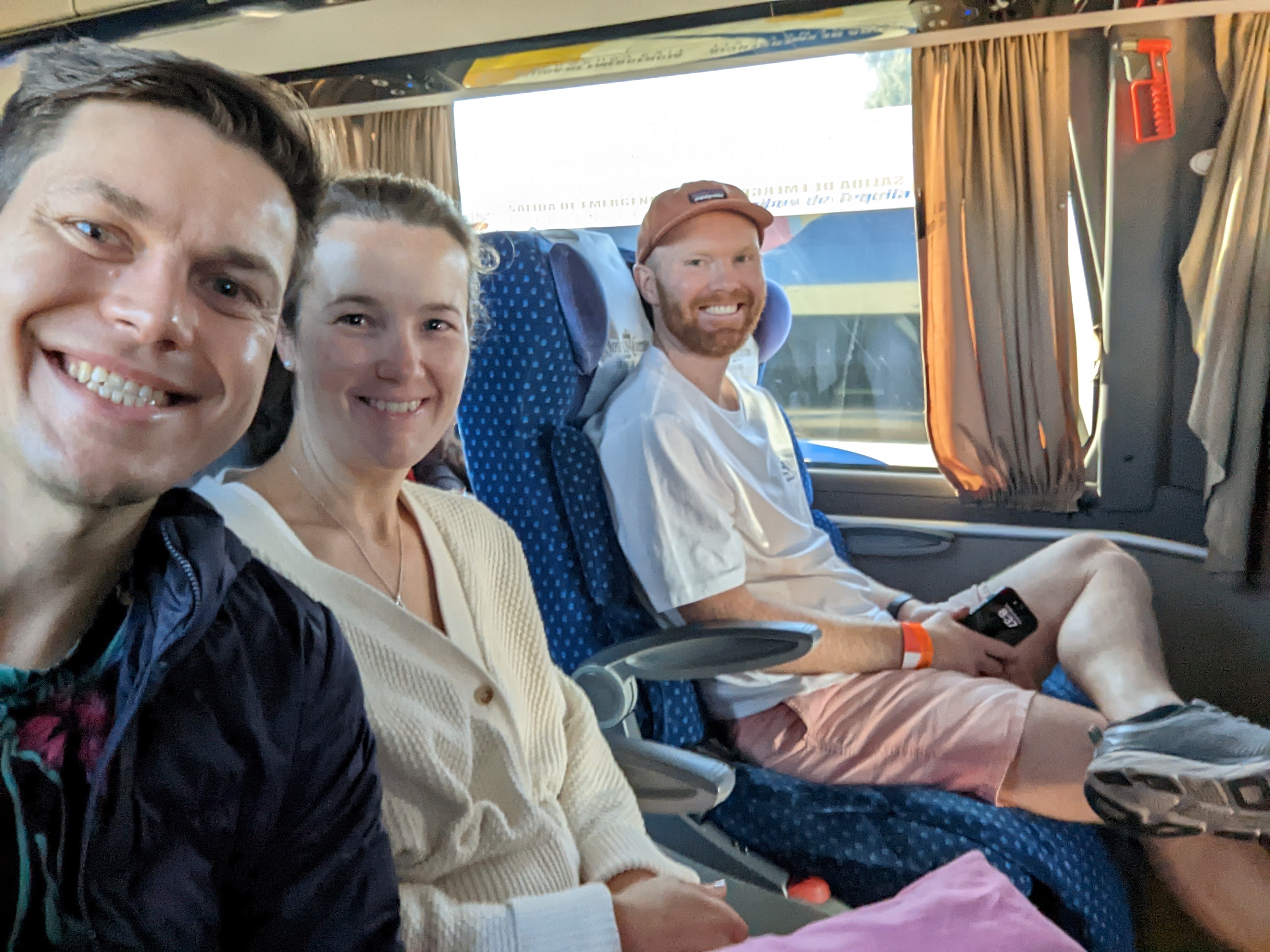
On the bus for our Jose Cuervo tequila tour
We met at a bus terminal at 8.00am to begin our journey to Tequila. On the way, we stopped at an agave field where, in smaller groups (us in the English speaking one), we learnt about blue agave, the species used exclusively for tequila, and how it is grown and cultivated for tequila production.
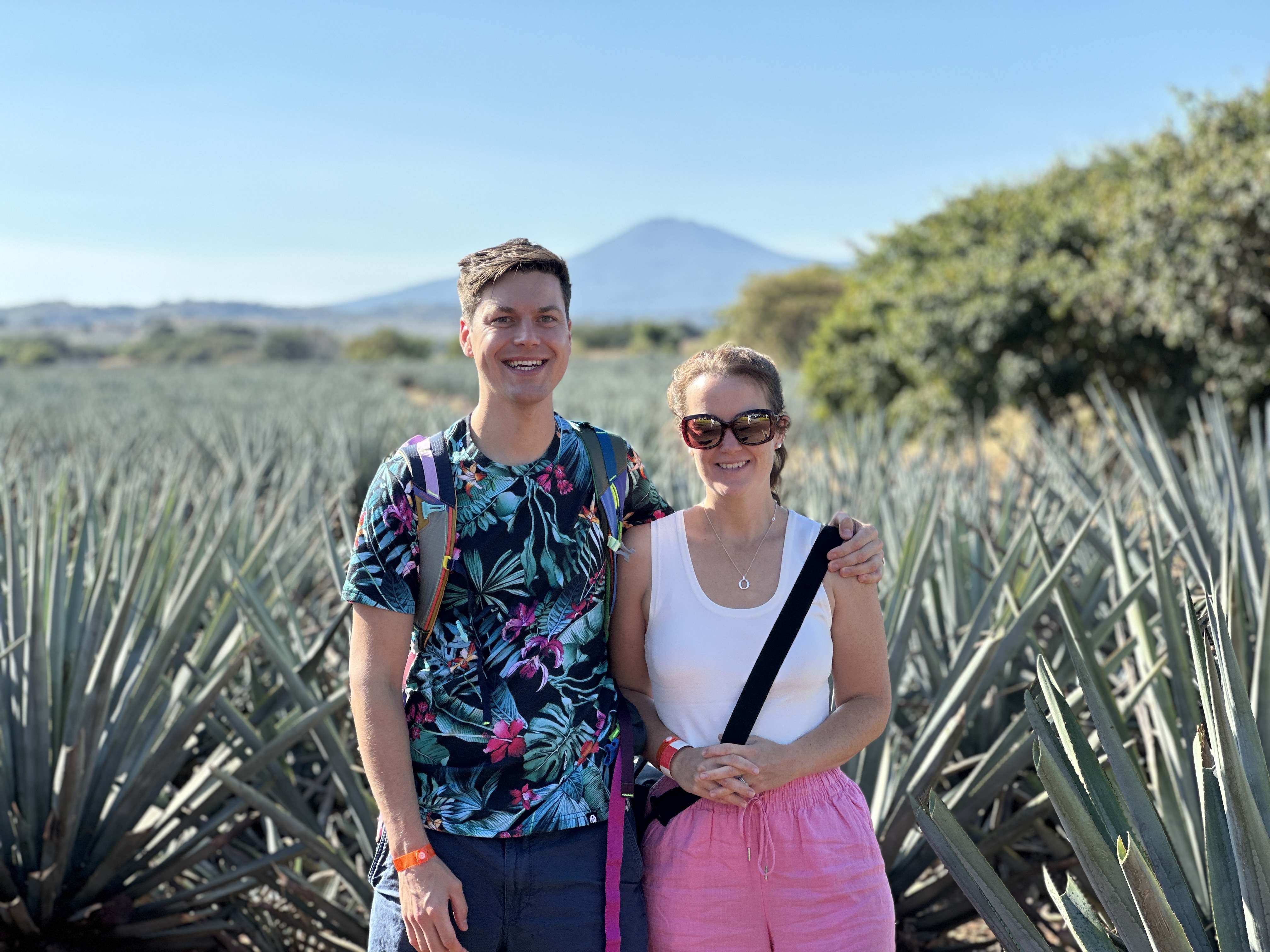
In the agave fields
We ate a morning tea of tamales here and the tequila started flowing. By the time we were back on our bus at 11.00am, a loud group of trashy American girls were already pissed.
Sat at the front of our rowdy bus, we continued on to the magical town of Tequila. In Mexico, Pueblos Magicos are towns recognised by the Mexican government for their “magical” qualities, such as astonishing beauty, rich history, or extraordinary legends and are thereby granted this special status.
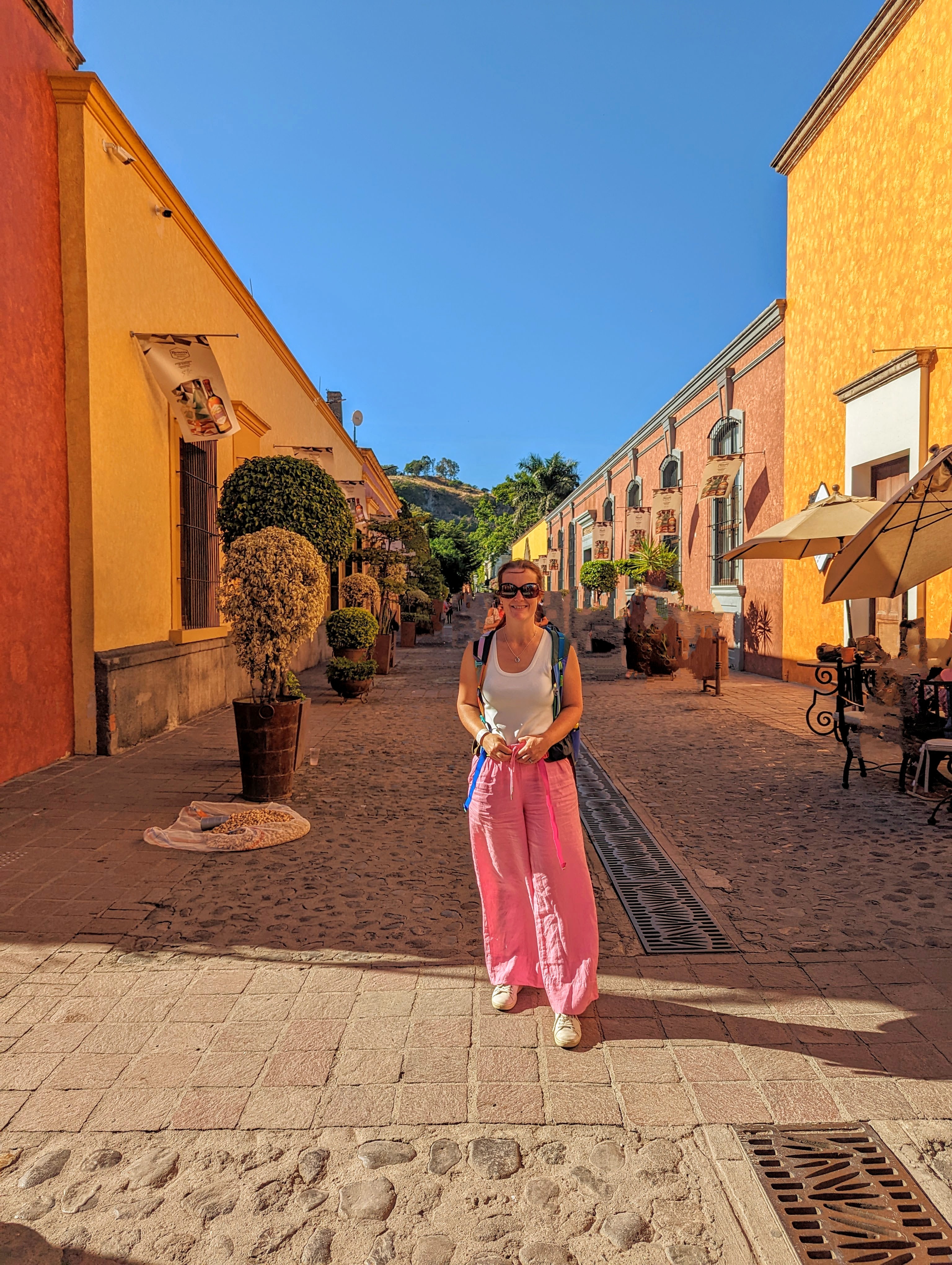
The magical town of Tequila
The town of Tequila is, of course, representative of this most-famous Mexican export, which with its AOC, or designation of origin, can only be made in certain parts of Mexico, principally in Jalisco. Jose Cuervo is probably the best-known and best-selling tequila brand in the world, and its distillery is touted as the oldest in Latin America with a history dating back to 1795.
So it is a place worth visiting, particularly for those like us who are interested in the history and making of spirits. However, like a lot of alcohol that becomes globally successful and subsequently produced in very large quantities, the quality deteriorates. Jose Cuervo tequila is no exception. Its run-of-the-mill tequila is woeful, hang-over inducing stuff, but the company does still make some well-regarded tequilas, notably its high-end Reserva de la Familia lines.
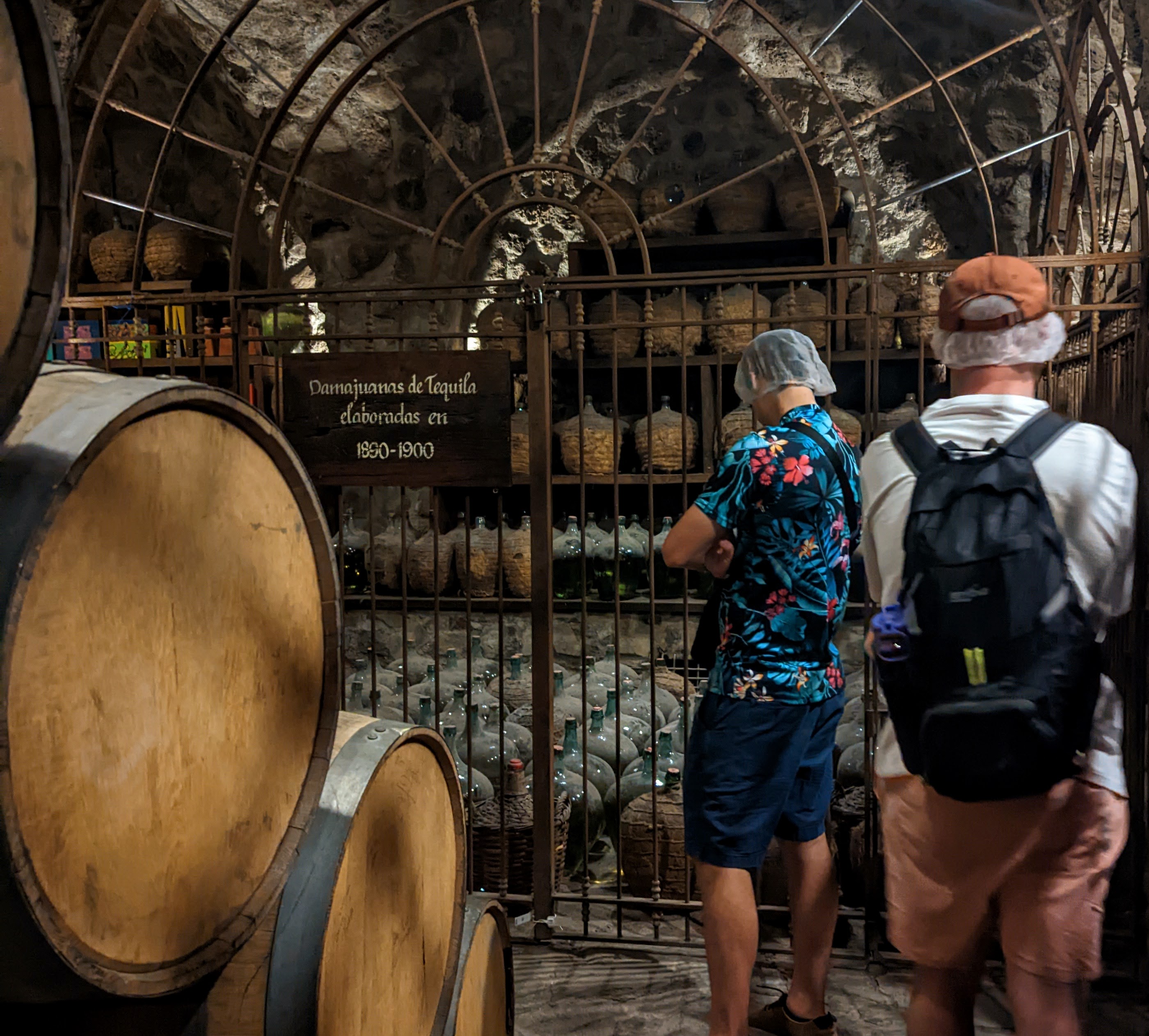
Inside the ancient underground cellar of the Jose Cuervo distillery
Our bus pulled up at Tequila and we disembarked, while trying to explain to our enthusiastic tour guide that our lack of participation in the morning tequila drinking was not an indication of our dislike for tequila. Sure, we were on a tequila tour, but we weren’t up for drinking shots of frightful tequila before noon.
We continued on to the Jose Cuervo distillery for a tour, learning about the process of distillation and watching the staff haul around giant 90kg piñas. Tequila is produced by removing the heart of the blue agave plant (called a piña) in its seventh to fourteenth year, depending on growth rate of the plant and what the harvester is selecting for. The harvested piña is cut in half or quarters, depending on the size, and then cooked and juiced, and the resulting juice then fermented and distilled.
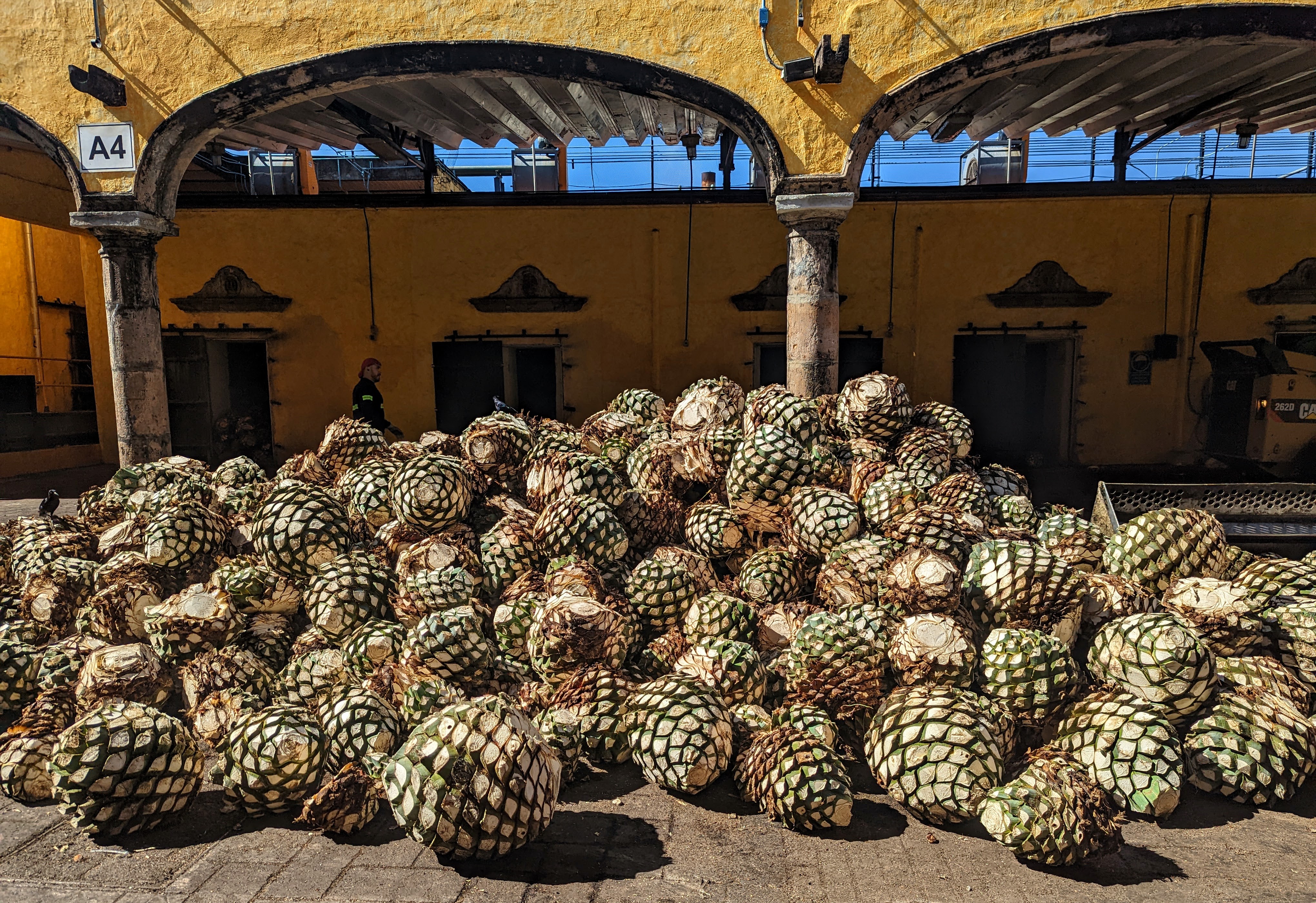
A pile of piñas at Jose Cuervo
After our tour we had some free time to explore the town and have lunch. The three of us avoided the rest of the tour group and found a small indoor market filled with locals where we enjoyed a casual lunch at the bar of one of the stalls, hoping that the presence of a kitchen sink at this one would help us avoid food poisoning. Following our feed, we wandered around the town, stopping in at a bottle shop to buy a rare tequila, bottled in a beautiful hand painted bottle of a pink and turquoise design.
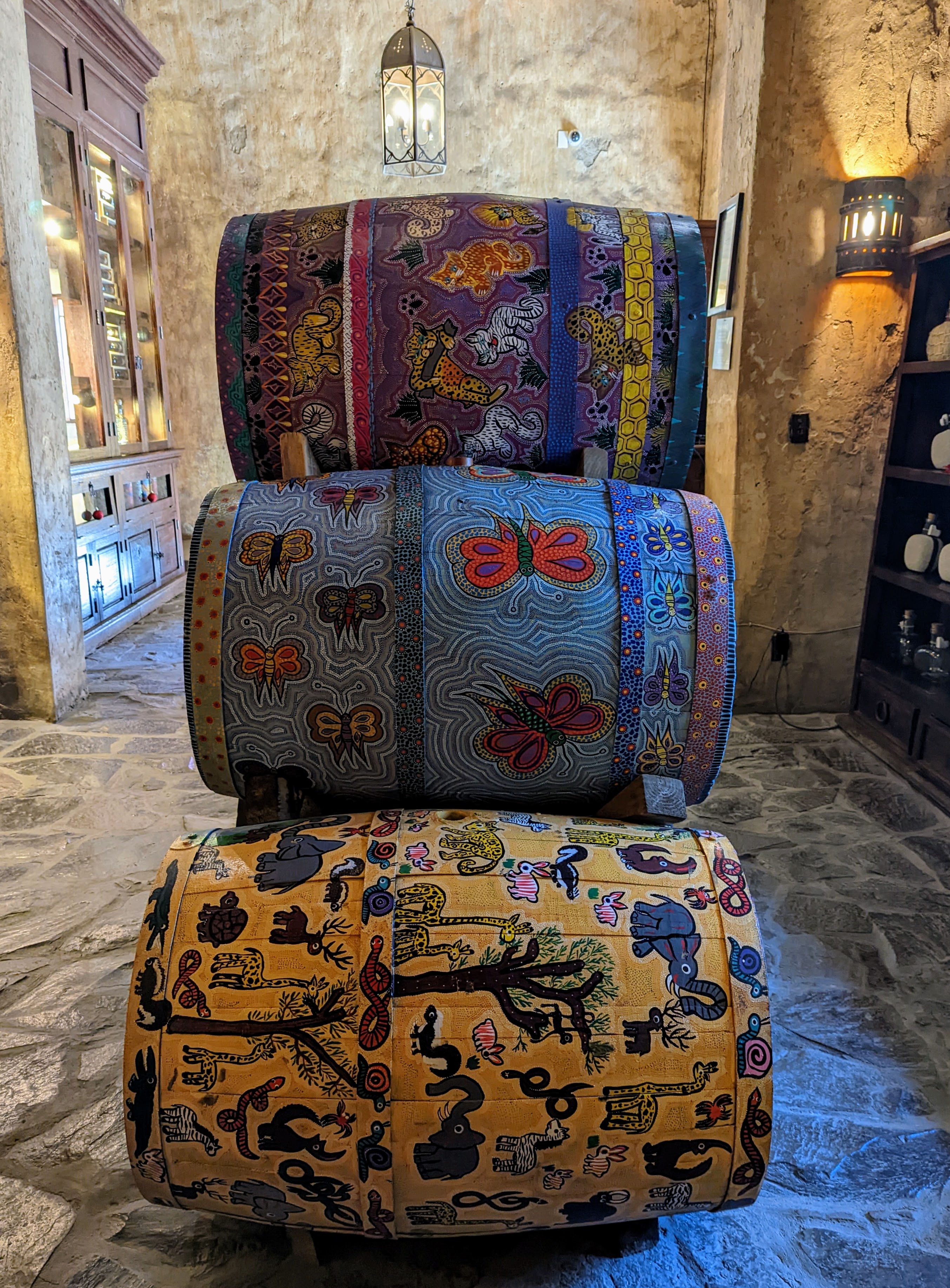
Painted barrels in the bottle shop
We then joined up with the hundreds of others on the tour at an auditorium where we watched a performance of mariachi and dancers, as tequila slushies were brought around. The combination of a musical tradition dating back some 200 years with frozen margaritas was yet another comical revelation of the day’s tour. Now with lunch done, we started our tequila consumption for the day. Although we harshly judge the American-made butchering of a classic cocktail we’re not too high brow to enjoy one. Meanwhile, the group of American girls had seemingly had their fill of bad tequila, now looking forlorn and perhaps on the verge of being ill, as they took in the show.
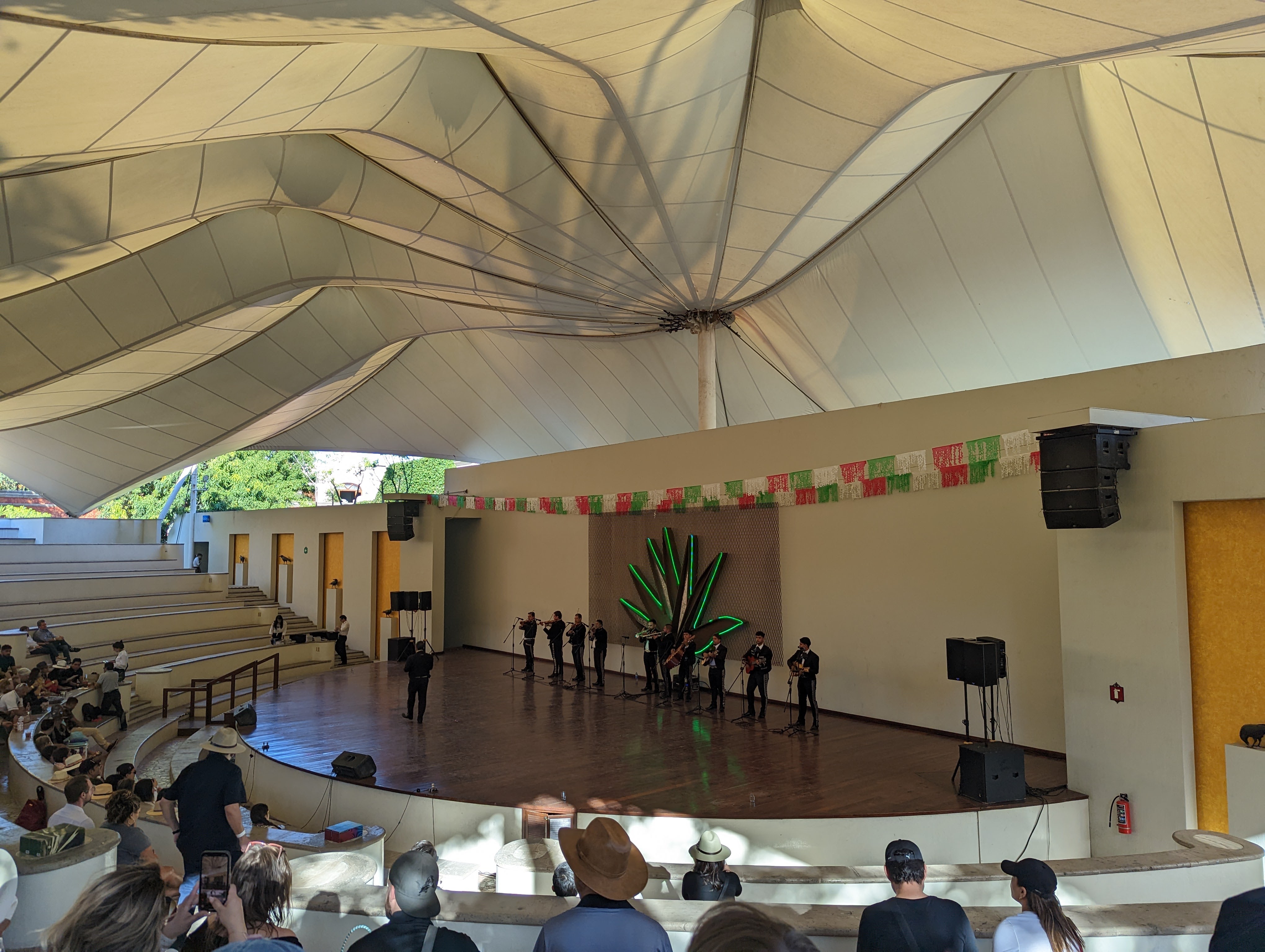
Waiting for the mariachi show to begin
Show over, we boarded our bus and headed for the train station, and the most anticipated part of the tour. To complete the day, we would be taking the historic Jose Cuervo train from Tequila back to Guadalajara and during the journey be served dinner and tequila-based cocktails.
By this point in the day we should not have been surprised but the experience that ensued on the train still came as a shock. We paid for premium seats and were anticipating a peaceful train ride back through the agave fields, watching the sun setting as we enjoyed our meal and refined conversation. Instead, what followed was a wild train party. In our train cart was a group of Mexicans on their work Christmas party absolutely thrilled to have a random bunch of Australians in their carriage. They had no reservations in requesting more and more cocktails from the train staff and so, the drinks kept coming, and so did another bottle of tequila they’d brought which got passed around.
It was not the experience we thought we were going to have, but it was the best one we could have had. It was wild and fun and exactly the kind of encounter you hope to have while travelling, but can never guarantee that you do. We got off the train, having consumed enough tequila to surely please our tour guide.

At the station in Guadalajara after our train ride
For our time in Guadalajara, we stayed in the trendy neighbourhood of Colonia Americana in a tall apartment building with a rooftop pool and fitness centre. The December weather was perfect; sunny skies and 28°C everyday. During our lazy afternoons, often following a taco lunch, Max and I sat by the rooftop pool, him enjoying a beer and me a rosé while we waited for Dylan to finish up work so we could all head out to dinner.
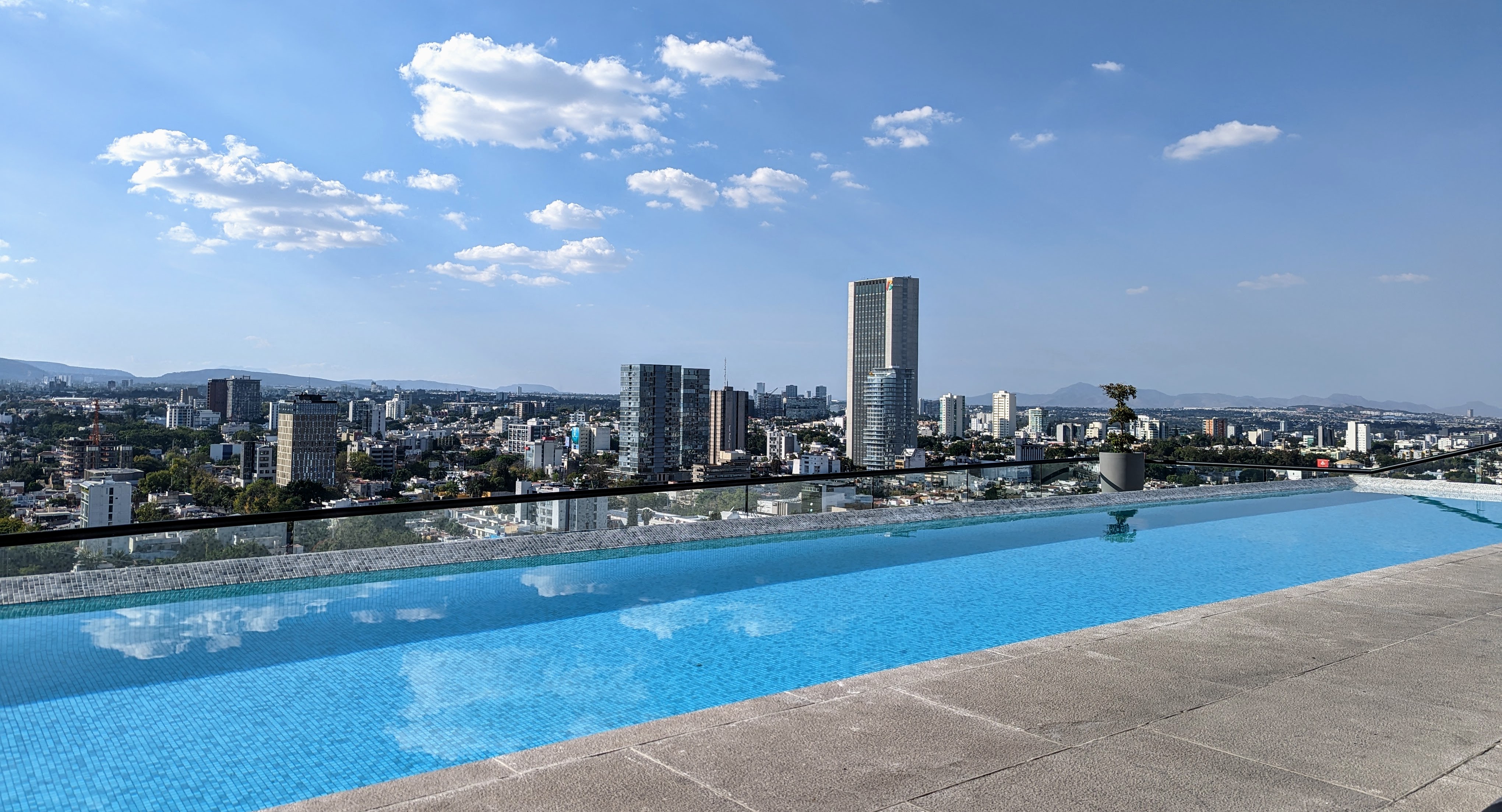
The rooftop pool
Our best lunch was at Taqueria Mexico. I ordered a bunch of tacos I understood the meanings of and then struggled through ordering some to take away so that we could bring some back for Dylan. The pork belly taco was incredible. Max and I ordered at least five and then another two for Dylan. It’s amazing how a bit of meat on a tortilla with a small sprinkling of onion, cilantro and lime juice can taste so good.
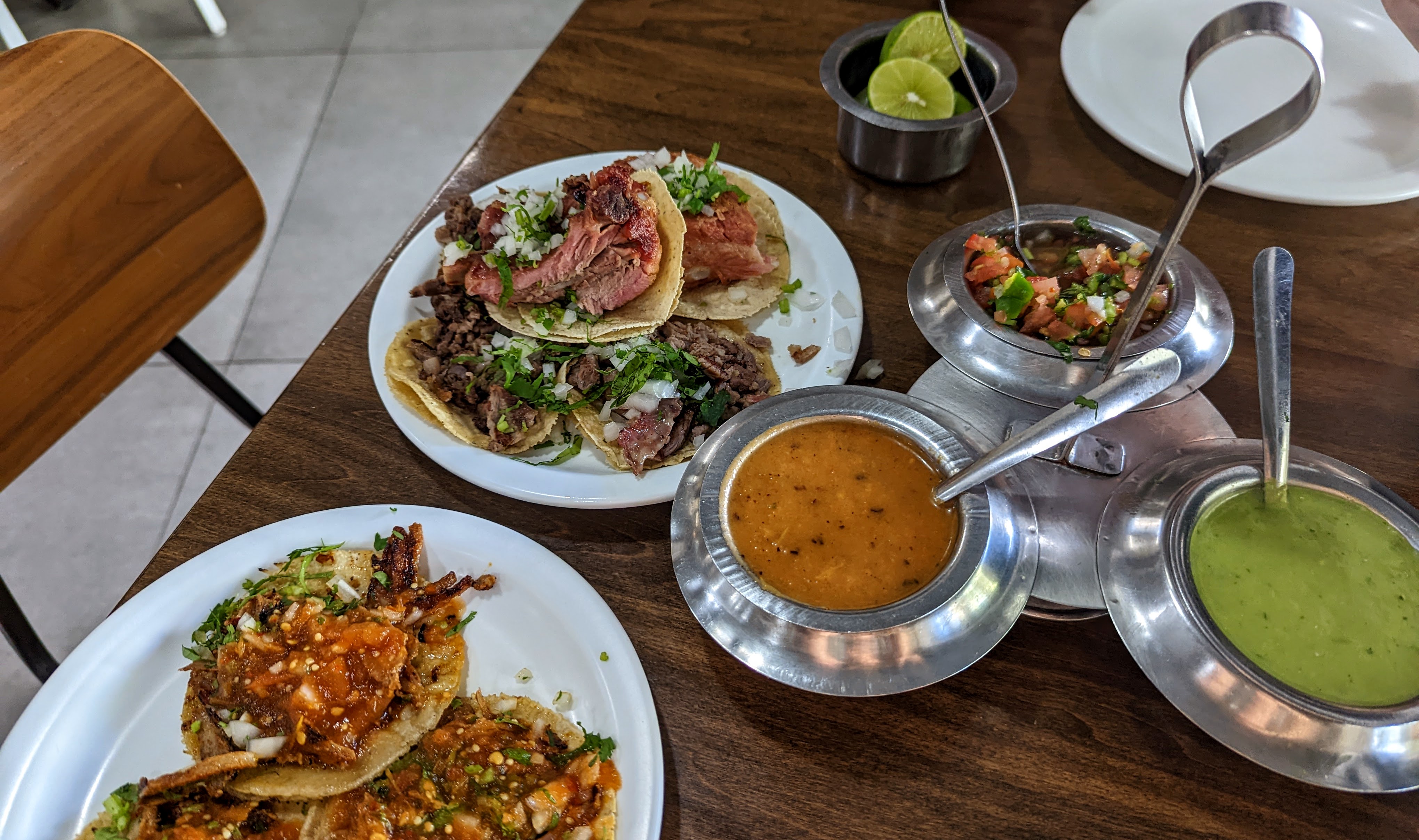
Tacos at Taqueria Mexico
A few months prior when Dylan and I were in the Galapagos, we met a family that was from Guadalajara and they had provided us recommendations for restaurants as well as an instruction to visit Tlaquepaque, a nearby city, where the town centre streets are filled with boutique shops of artisans selling all sorts of handmade goods.
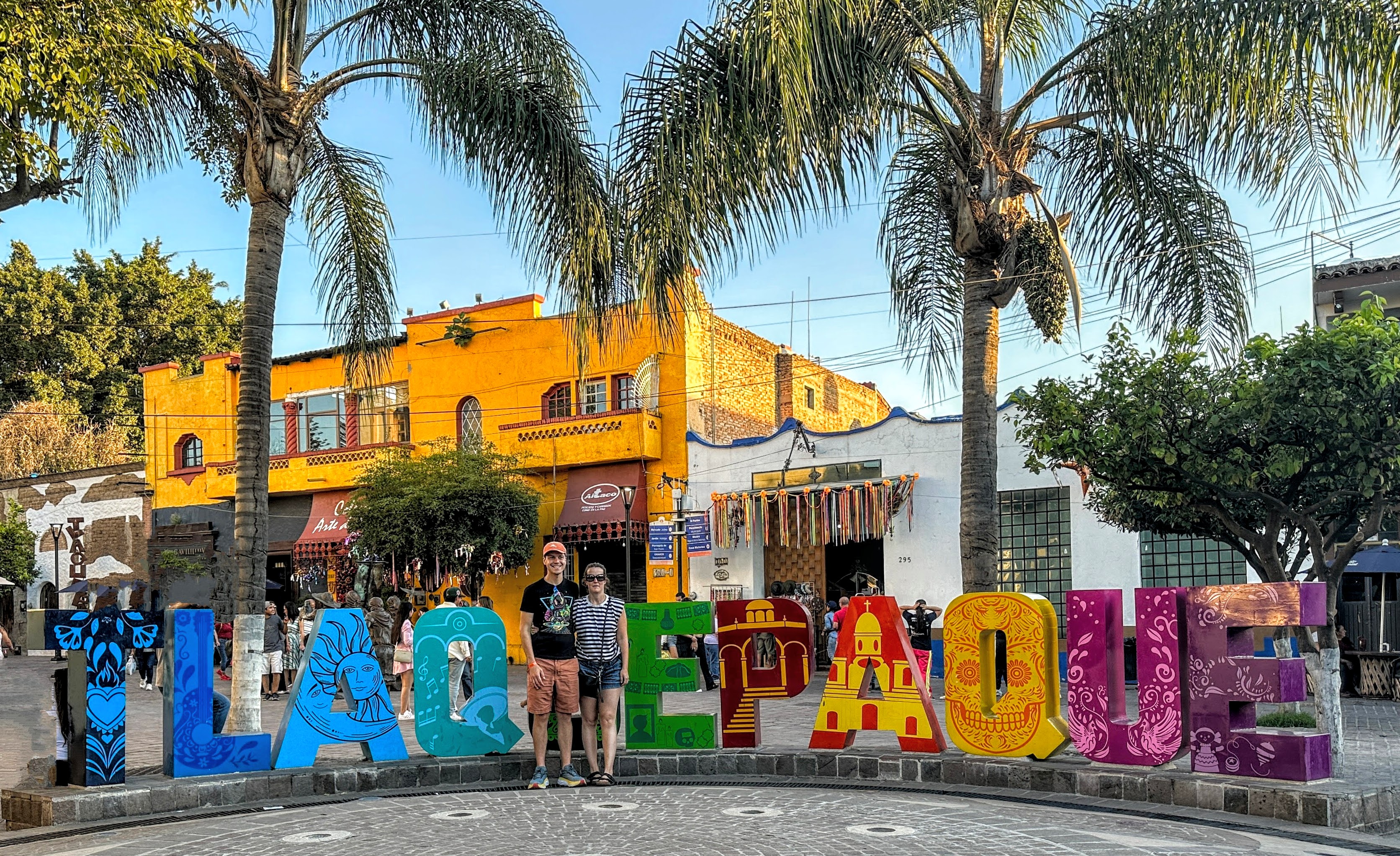
Obligatory photo in front of the Tlaquepaque sign
On the weekend, we explored Tlaquepaque, wandering the colourful streets and checking out all the boutiques. After much deliberation, Dylan and I ordered a dinner set in our chosen design from a store specialising in beautiful hand painted ceramics. We paid and arranged for it to be shipped to Australia after it was finished, which would be in some three to four months’ time. Afterwards, we reflected on the trust we placed in this shop by handing over our money and hoping our goods arrive in Sydney at some unknown time in the future. We also bought a blown glass jug and matching highballs from another shop, which we arranged to also be included in the shipping crate with the dinner set.
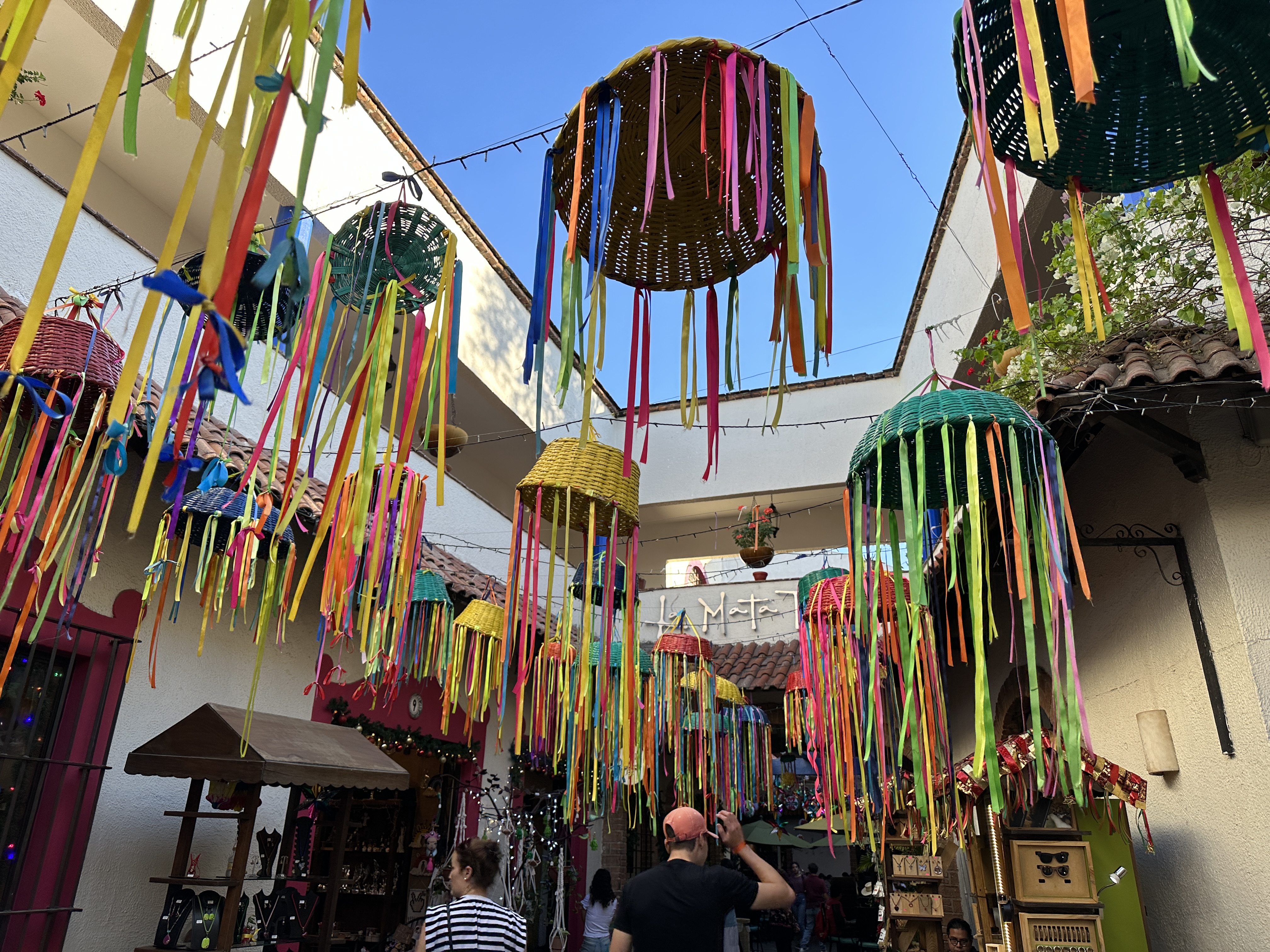
Wandering the streets of Tlaquepaque
Max and Dylan also did a tequila and mezcal tasting while we were there. We spent about two hours in the tasting room with the host chatting animatedly about Mexican spirit culture. We bought a couple of bottles, which Max packed in his suitcase to take home for us.
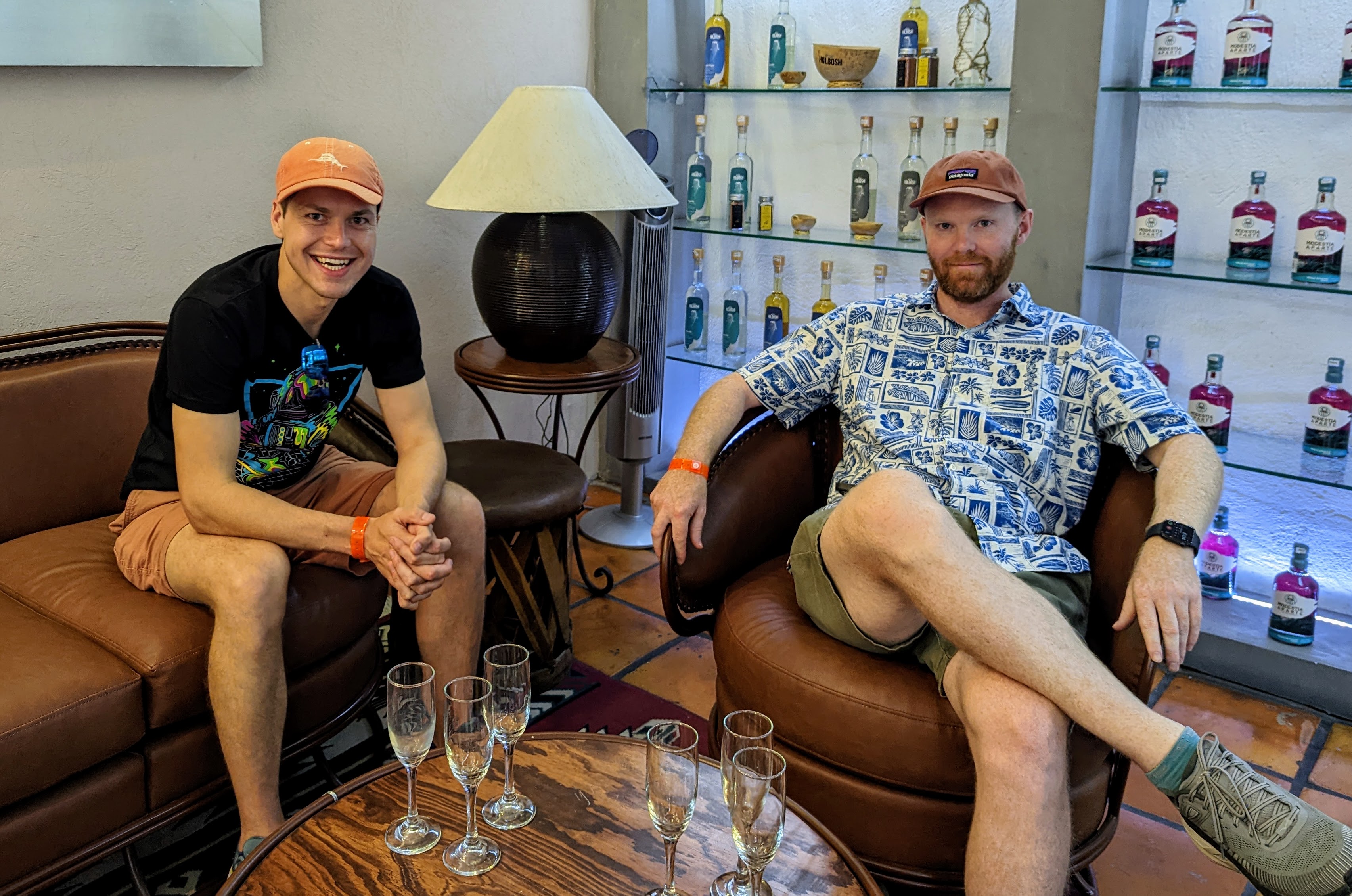
Tequila and mezcal tasting in Tlaquepaque
During the week, Max and I left Dylan working and went on a walking tour of Guadalajara city. We wandered through the historical centre, already set up for Christmas celebrations with tall Christmas trees in the squares, a gondola adorned in large red poinsettias, and lights strung on the town hall. With the clear blue sky above and a temperature hovering at 28°C, it reminded me warmly of Christmas at home.
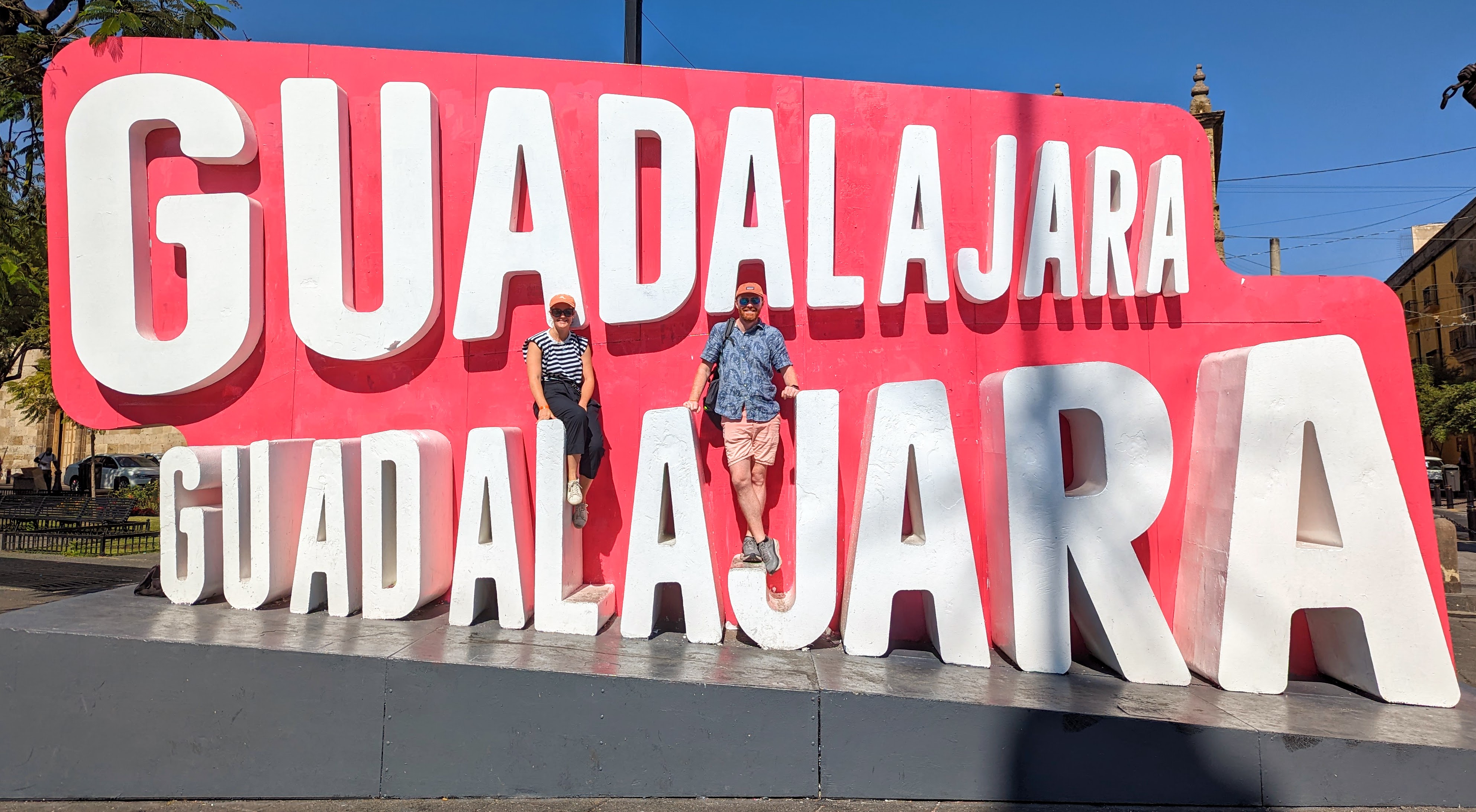
Walking tour in Guadalajara
During our tour, we learnt about the history of this region and the indigenous tribes that inhabited the area, the arrival of the Spanish and subsequent evolution of the city, seen through its colonial architecture, museums and art. We visited a number of historical buildings but none more impressive than the Hospicio Cabañas, an enormous 18th century building that was formerly a hospice and is now a museum and art gallery, famous for its works by artist José Clemente Orozco.
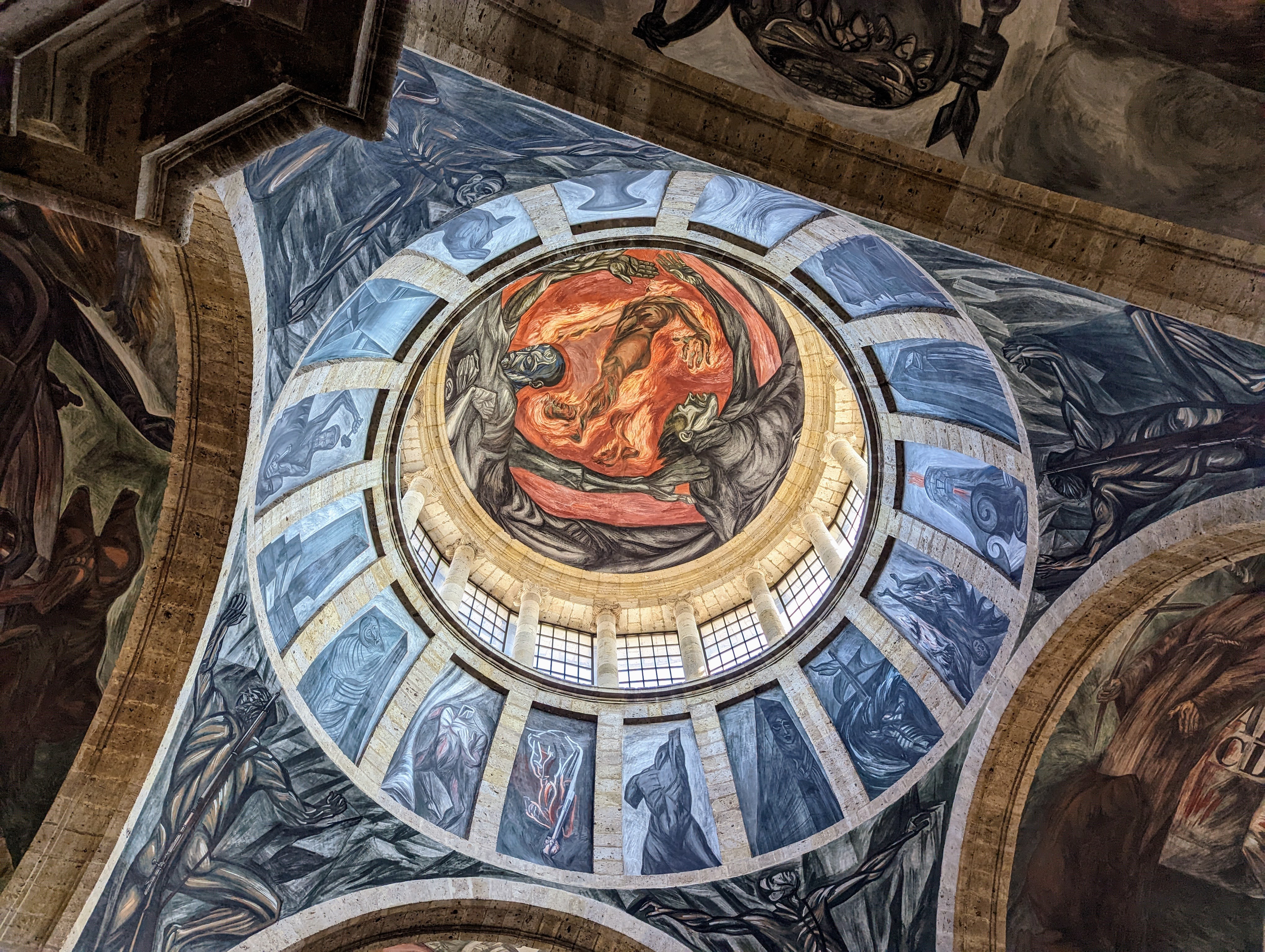
An artwork by José Clemente Orozco on a ceiling in the Hospicio Cabañas
We ate a lot of good food in Guadalajara. In fact, we didn’t eat a single bad meal while we were there. But one of our best dining experiences of the week was eating carnes en su jugo (meat in its juices) at the eponymous restaurant Carnes en su Jugo Mexicaltzingo 1617. It is a local dish and the creation at this restaurant was delicious.
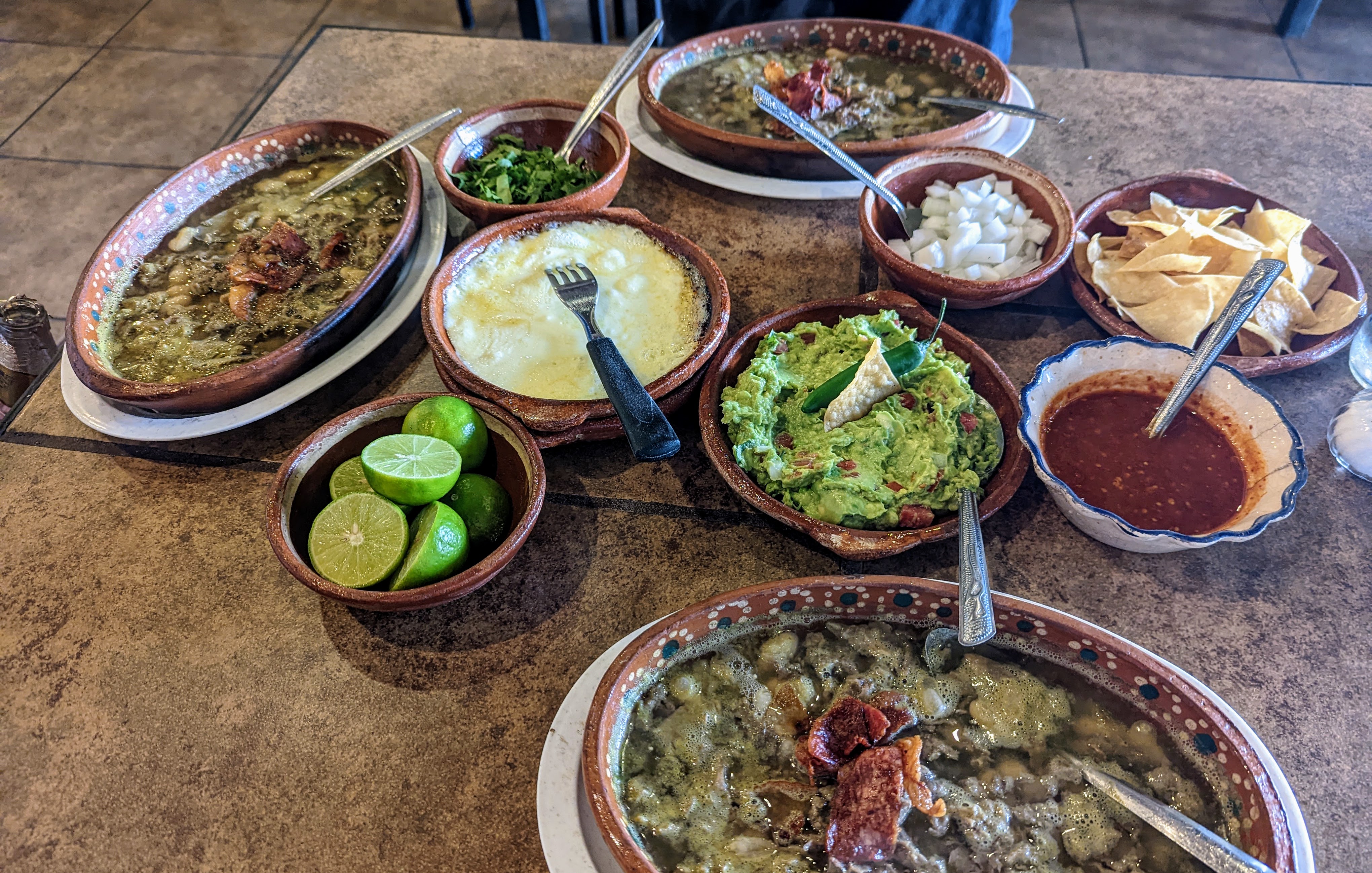
The carnes en su jugo
It was an intimate, family-owned restaurant, the husband serving and the wife cooking out the back. The service was warm and welcoming and we ordered exactly what we were told was best and were not disappointed. The owner gave us a free dessert, in exchange for a review, and took a polaroid to put on his wall.
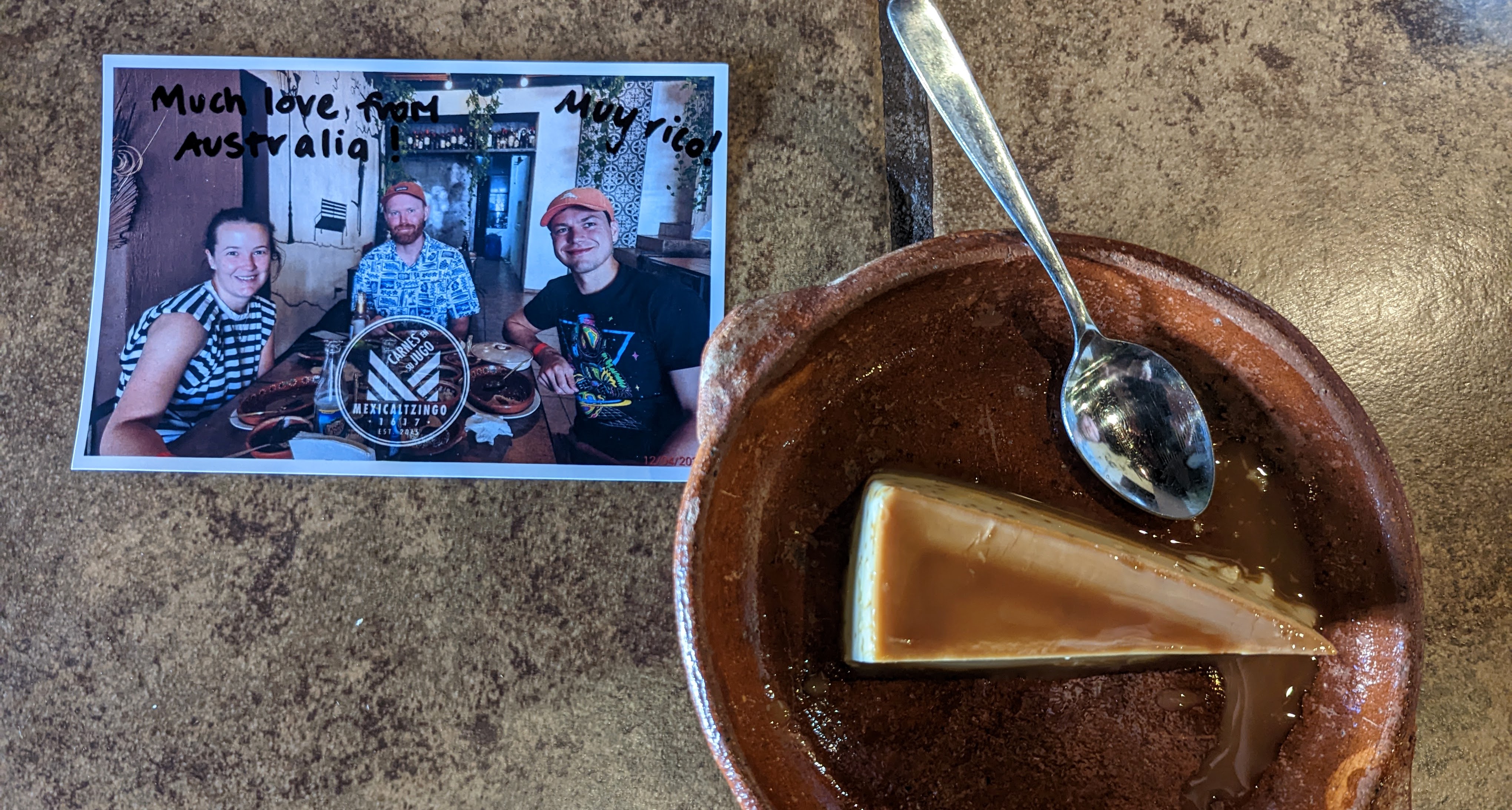
Dessert and a polaroid
We also enjoyed exceptional meals at the casual Tomate Taqueria, and high-end dining experiences at Xokol and the very popular Bruna.
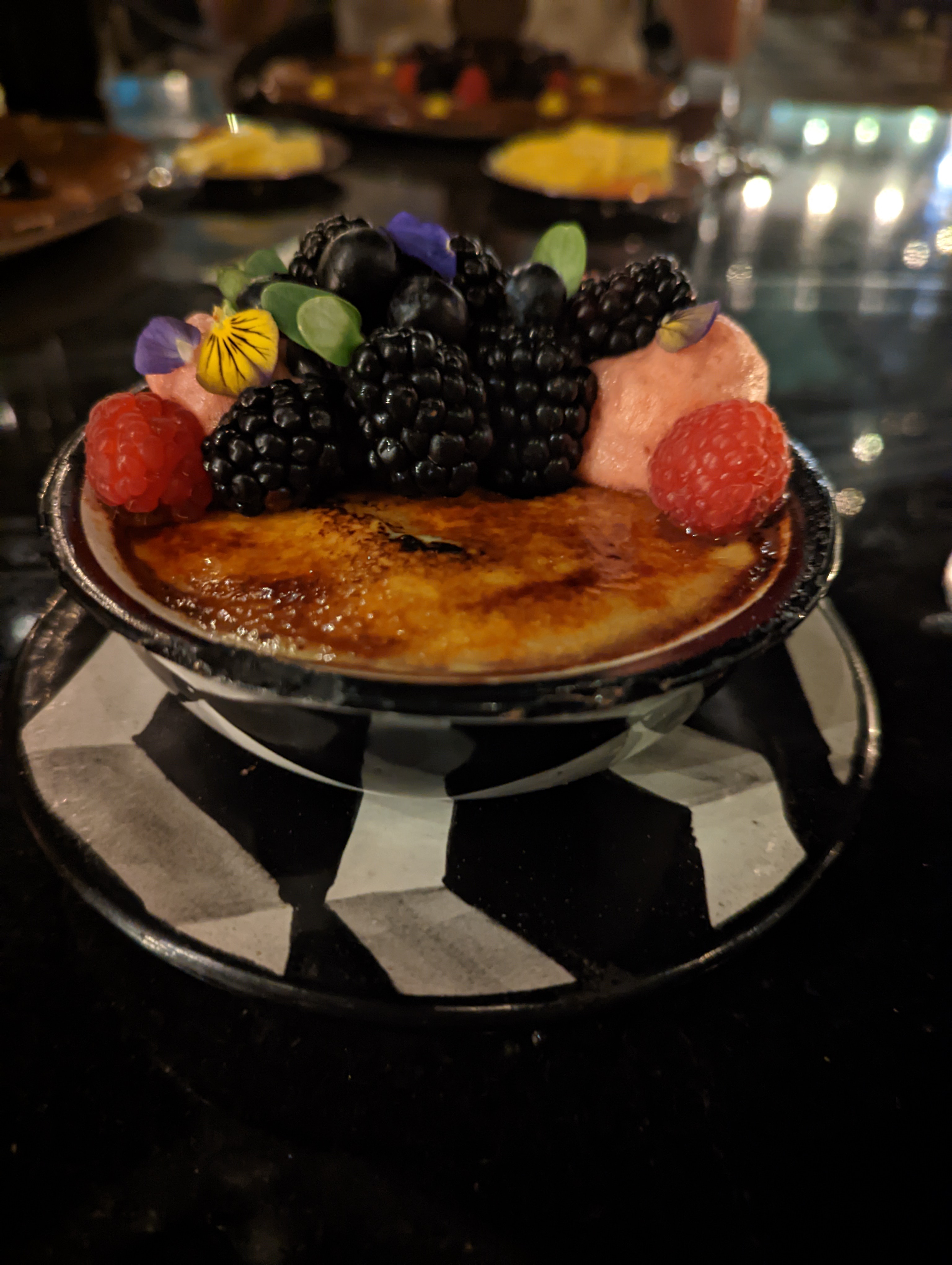
A Oaxacan chocolate crème brulée dessert at Bruna
We also had decent cocktails at De La O Cantina and Fat Charlie. In our experience, we struggle to find bars that serve well balanced cocktails that have enough alcohol content in Latin America. Maybe that’s a terrible generalisation, but in the past few months we’ve been to many cocktail bars in Colombia, Ecuador, Costa Rica and Mexico and keep having the same experience. While you can find pleasant cocktails with interesting ingredients, they are never strong enough. These were much the same; the taste was good but they just didn’t have the right ratio of spirits to other ingredients.
A week after our arrival in Mexico, we three amigos continued on our Mexico adventure, leaving Guadalajara behind and heading to Oaxaca, a southern state considered by many to be the culinary capital of Mexico. We stayed in Oaxaca City, a small UNESCO World Heritage city in the centre of the state.
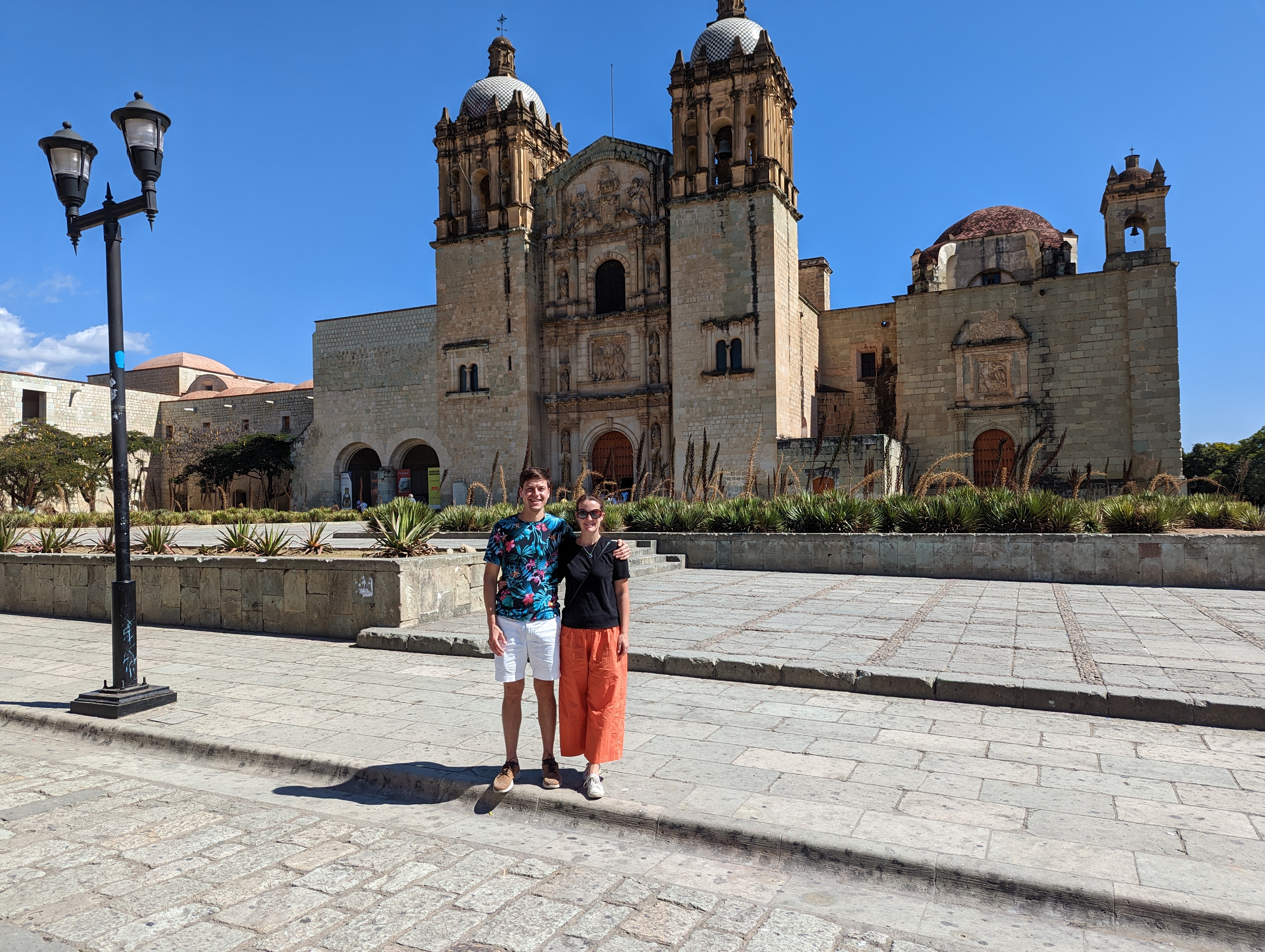
In the old town of Oaxaca City
We stayed at the beautiful Hotel de la Parra in the historic centre for two nights. Our stay here was brief as Dylan and I were in Oaxaca to join our Gastronomad Experience for 5 days, where we would explore Oaxaca, and its cuisine, in much more depth.
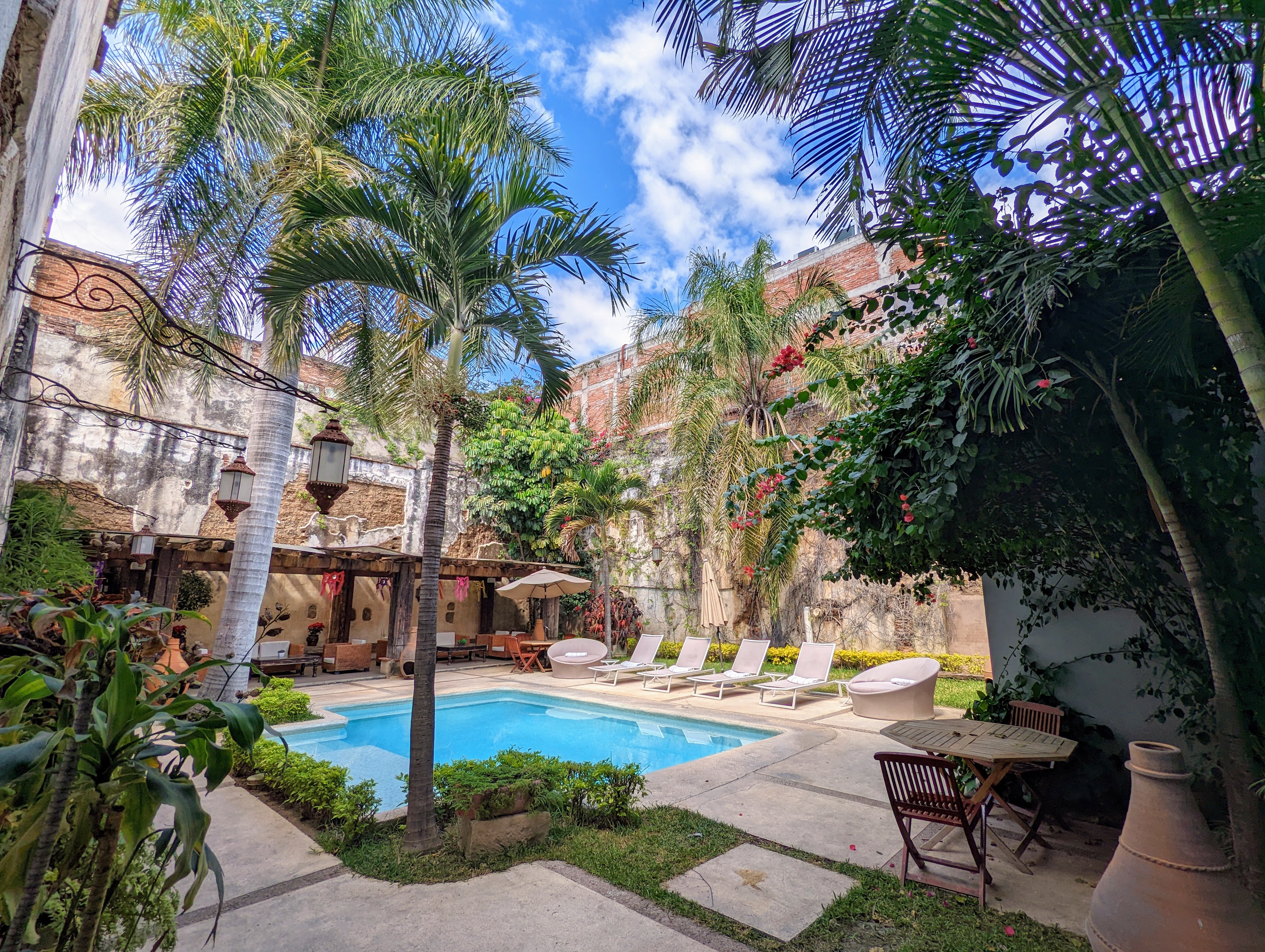
The courtyard at Hotel de la Parra
Oaxaca is famous for its agave spirit, mezcal, as well as its chocolate and moles. While moles can be found in many parts of Mexico, Oaxaca has the greatest variety, often being referred to as the ‘land of the 7 moles’.

A wall of mezcal bottles at a market in Oaxaca City
During our two days in Oaxaca City, our culinary highlight was dinner at the restaurant Los Danzantes where we had a delicious tasting plate of moles along with other amazing meals in a spectacular outdoor dining area. We also enjoyed drinks at the exquisitely decorated Selva Oaxaca cocktail bar and at a grungy, newly opened bar called Marsupial - La Mezcalería.
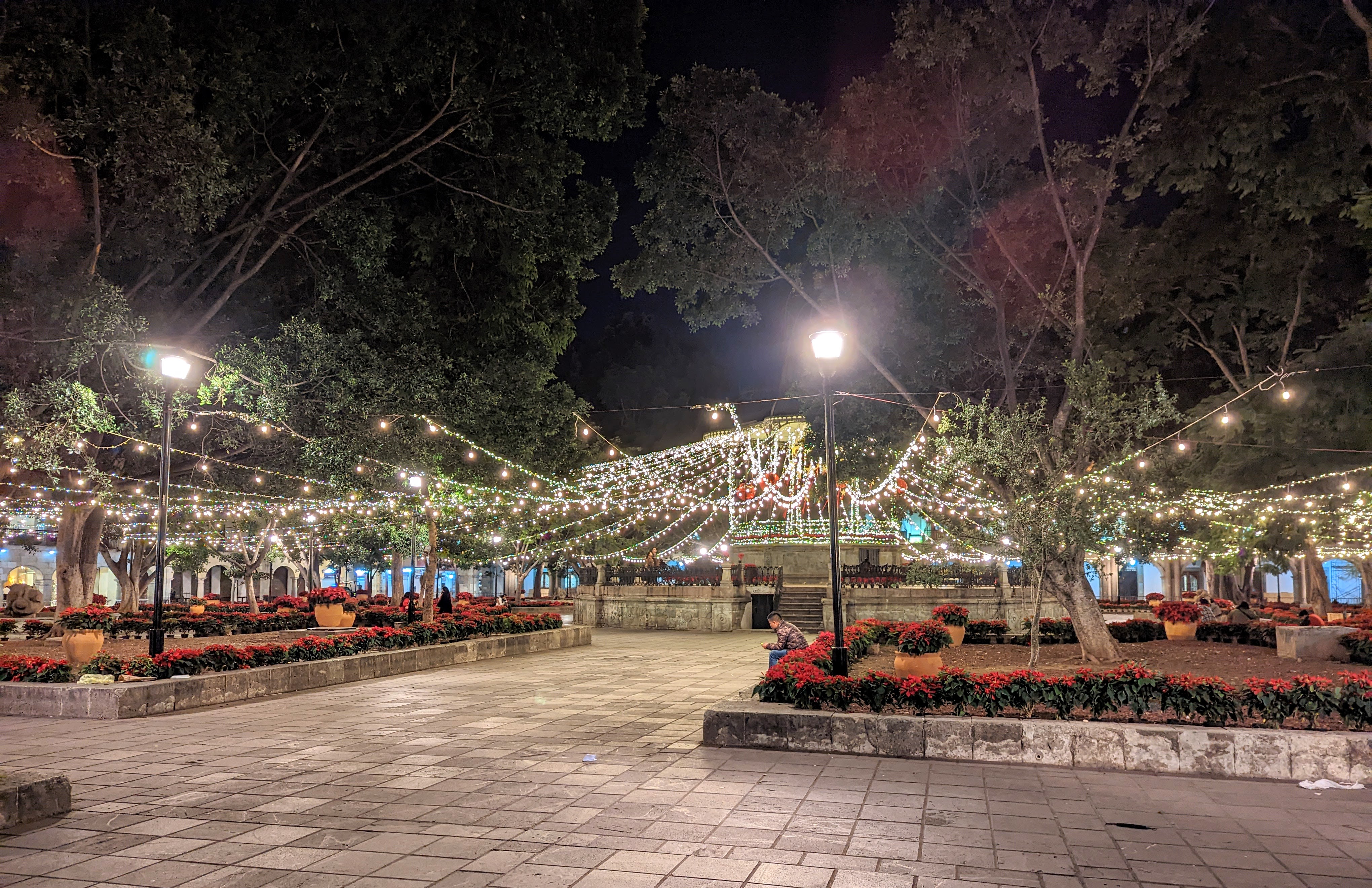
The main square decorated for Christmas with fairy lights and hundreds of poinsettias
We loved Oaxaca City and were very glad that after this small introduction we would then be guided around this culinary capital with experts who have dedicated years to finding the best food and cultural experiences around the world.